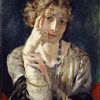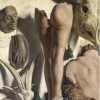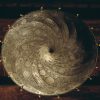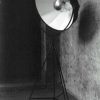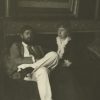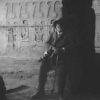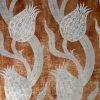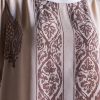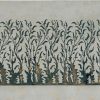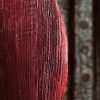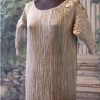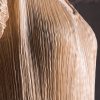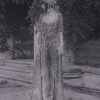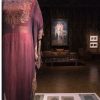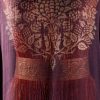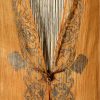The collections within the museum comprise an extensive number of pieces and materials which reflect the various fields investigated in the artist’s work. These are organised under certain specific headings: painting, light, photography, fabrics and clothes design.
Painting. The collection contains some 150 paintings by Mariano Fortuny, which illustrate the various phases in this aspect of his career as an artist.The Wagnerian period, up until 1899, holds a central place. This meeting and blissful balance of painting and theatre mark an intimate understanding of the dream and myth that thrilled Europe at the end of the nineteenth century. Equally fascinating, for other reasons, are the portraits, in which the family, and particularly his wife Henriette, play a fundamental role: here inspiration becomes an intimate chronicle in the context of stylistic inheritance from his maternal relations: Federico de Madrazo, his grandfather; his uncles Raymundo and Ricardo; his friend Boldini. 1888: the Study of the Female Nude made when he was just seventeen years old is the first pictorial attempt known by the young Mariano. This theme, which he continued referring back to (the latest of these exhibited here, Reclining Female Nude, is from 1946), became the palimpsest of techniques and styles interwoven even through his photographic work. The two large still lifes seem to be the fruit of a crossover between Fortuny’s education and his original compositional ability.
Light. The main driving force and real heart of Fortuny’s work is light: perfectly identified with the creation of the celebrated theatre dome. The same light is found in his assiduous chromatic studies, in his dying of textiles, his shot fabrics and, consequently, in many objects designed for furnishing. A notable example is the large ivory, silk gauze curtain, printed in black with oriental motifs, all played out on the transparency of the silky material and on the graphic contrast of the design which increases and expands light throughout the entire space. The extraordinary lamps and chandeliers, all in the same stamped and painted material, follow the same line of study. These almost immaterial objects, derived from various subjects and references, such as the Saracen shield, with exotic names (Sherazade), or inspired by the celestial world (Saturn), evoke atmosphere and splendour in rooms where light and design constitute an inseparable singularity. With their solid, metal construction and clean lines, the Fortuny diffusor lamps are absolutely practical and functional for the specific lighting of various types of room, works of art and architecture, while still representing the best that has been conceived for the use of diffuse and indirect light.
Photography. The core of photographs shown here are taken from either the collection left by Mariano Fortuny or the the rich collection of the Musei Civici di Venezia, both are which are now undergoing full re-organisation within the Fortuny Museum itself. The entire collection comprises works from 1850 to the Second World War, with a rich variety of styles, techniques and historic images.
Mariano Fortuny photographer
As a photographer, Mariano Fortuny is in many ways different to the retiring star of fashion and art.
Though even here one can see his command of the medium and his capacity to move the viewer, there is no doubt that Fortuny neither was – nor aimed to be – a professional photographer; as is well known, he used the camera mainly as an tool for his work as a scenographer and textile designer.
Nevertheless, even here he inevitably reveals his eye as an artist: in the private shots and the pictures taken as an aide-memoire, he certainly achieved results that bear comparison with those of the more famous photographers amongst his contemporaries.
The photographs of Mariano collected at the Fortuny Museum, show family groups, friends and the famous celebrities who formed part of Fortuny’s social circle, travel notes, interior shots, self-portraits and images of the less well-known corners of Venice
Fabrics. The Fortuny Museum’s collection of clothes, fabrics, trial prints, materials and ornamental clothes of one type or another make up a rich sample of Fortuny’s extraordinary work in the field of fabrics and fashion design, in which the artist took old ornamental motifs and reinterpreted them in a very “modern” decorative style.
The fabrics range from the simple diagonal-striped cotton cloth to velvets of silk and cotton (the perfect material for the famous polychrome printing, which was used mainly for furnishing fabrics).
The satin, the taffeta, the silk gauze and the velvets constitute the material for the Delphos, the surcoats, the sumptuous cloaks and capes, all imbued with infinite chromatic blendings and historical references.
Fortuny drew decorative models and designs from precious Renaissance velvets and from fabrics from distant, exotic cultures which, once printed, imitated and reinvented the original handicraft, thanks to a highly personal system of printing with inimitable material and three dimensional results.
The Delphos
The greatest success of Mariano Fortuny’s workshop was the creation, in 1909, of the Delphos, the iconic simple monochrome gown that took inspiration from the greek myths.
In terms of style, the dress was mainly inspired by the Hellenistic classical sculpture of the Charioteer of Delphi, discovered in 1896.
With an autograph note written in the margin of the patent, Fortuny recognises that the true creator of the Delphos was Henriette.
Some models, introduced in the market in the 1920s and commercialised under the name of Peplos, included a section of cloth, known in ancient Greece as the apoptygma, that was folded to cover the torso for about a third of the length of the upper side of the gown.
The Delphos, was a monochrome gown of a simple, essential form, a sort of cylinder initially consisting of four pieces of fabric (which by 1919–20 had become five) made in satin or silk taffeta sewn along the long sides in a vertical sequence and continuing to form short sleeves.
The gown, shaped by internal tapes arranged at an angle from the armpit to the shoulder to define the armhole, rested on the shoulders and fell freely down to the feet. The neckline and the sleeves were adjustable thanks to drawstrings in silk cord, embellished with beads of Murano glass paste.
The most important feature of the gown is the pleating. At first, it was done manually using the fingernail of the thumb, then firmed with sewing and pressed. The dense vertical waves on each panel that made the vest could reach up to 450 foldings.
The pleating, realised only in the longitudinal direction, could be enriched with a tranverse wave motion, obtained with the aid of copper tubes or heated ceramic.
The tones of the fabric varied from more muted and neutral colours, such as apricot, mauve, pearl grey or pink, to bright colours like coral red, ultramarine blue, or Veronese green, to produce iridescent shades resulting from the silk and the movement of the pleats.
A number of femmes fatales established the trend for this refined and long-lasting fashion, with the Delphos gown being immediately recognised. The Delphos got to be worn by the famous aristocratic ladies and international nobility, as well as divine dancers and actresses, wore this revolutionary piece of clothing casually.
Il Delphos fu indossato da famose dame dell’aristocrazia e della nobiltà internazionale, così come da divine danzatrici e attrici, che ne sancirono il successo mondiale.
The Marchesa Luisa Casati was the first one to purchase a Delphos Dress in September 1909.
The Delphos dress was usually worn with a belt in printed silk satin or taffeta; it could be matched with other Fortuny creations like the Knossos shawl or surcoats in silk gauze with or without sleeves, or jackets, tunics or capes of silk or printed velvet.
Downloads
![]() ENG / Mariano Fortuny and his Palace
ENG / Mariano Fortuny and his Palace
(PDF 1345 Kb) – short version
The history, the building, collections and general information >

